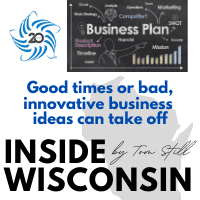 By Tom Still
By Tom Still
MADISON, Wis. – More than a year after the pandemic hit, some basic trends have emerged in the economy. Here are two:
- Many tried-and-true ways of doing business have changed for the foreseeable future and clever innovators are turning disruption into gain.
- Business and societal problems (and related opportunities) that cried out for attention before COVID-19 haven’t gone away.
Those two notions characterize the top 25 entries in the 2021 Wisconsin Governor’s Business Plan Contest, which began with 250 applicants more than two months ago and has since been narrowed by two rounds of judging.
Another round of judging from the contest’s more than 80 judges awaits before the field is once again winnowed to a “Diligent Dozen” who will present during the Wisconsin Entrepreneurs’ Conference in June. It’s not too early, however, to call attention to a field that reflects a cross-section of business innovation.
The contest is built around four broad categories.
Advanced manufacturing ideas include a sustainable alternative to plastic containers used by restaurants; women’s recreational “shape wear” that is antimicrobial and designed to carry items such as smart phones, keys and wallets; sensors and software that remotely monitor and measure the water level of a well without opening it; a lightweight delivery vessel that improves the delivery conditions for food; and a high-rate wastewater treatment system that provides real-time treatment of municipal weather flows; and a simulator that removes time and cost while improving accuracy for industrial testing.
Plans tied to business services include a point-based reward system designed for renters and landlords; a publishing company for women; a multi-state scheduling system for court reporters and videographers; solutions that help people and businesses achieve landfill diversion goals; and a comprehensive curriculum that prepares students for a job in emergency dispatching.
Information technology plans include software that generates a 3D visualization based on information it reads; a platform that will pay farmers to take carbon dioxide from the air and store it in their fields; a low-cost video station that connects providers with patients in hard-to-reach places; a digital platform for consumers to schedule clinician house calls or telehealth calls for urgent or immediate care; a cybersecurity solution that alerts businesses to imminent fraud attacks targeting their brand, employees or customers; a free-to-enter story-writing contest for 3rd to 6th graders that digitizes and gamifies handwritten submissions; and a patented image analysis algorithm to quantify the severity of acne using smartphone photos.
Life sciences plans include a hydrogel-based cell that encapsulates oxygen-rich hemoglobin to mimic human blood cells; a drug that can alleviate chronic lung disease (BPD) in premature babies; a device that organizes and secures multiple medical tubes and cords to support patient therapy; a device for clinicians who care for patients after heart surgery by providing continuous atrial ECG monitoring; treatments to support women through the menopause transition by alleviating symptoms and preventing long-term memory decline; a non-sterile, rigid plastic attachment to standard insulin pen needles that is reusable for six months or more; and a device that allows users to ergonomically collect or dispense accurate, precise volumes of fluids.
Those ideas speak to trends in environmental mitigation and monitoring; health care diagnosis, treatment and access; education tech; cybersecurity; and everyday needs – food, shelter and exercise – that are fundamental to many people.
Common to all plans in the round of 25 is the notion of solving problems while making money doing so, which is essential to sustaining an idea, product or company. A few might be organized as non-profit corporations, either now or in the future, but “non-profit” isn’t a goal. It’s a hard-earned tax status.
Most finalists have a vision of scaling their enterprises, attracting investors and customers, and adding value to the Wisconsin economy. These ideas were born in Wisconsin and the entrepreneurs behind them want to stay here. They may also aspire to doing business nationally or well beyond – which many past finalists have done. In fact, those past finalists have collectively raised hundreds of millions of dollars and created thousands of jobs.
It’s easy to get caught up in, even consumed by, the tragedy of the pandemic. It’s encouraging to know that innovators have ideas to help move us all forward.
Still is president of the Wisconsin Technology Council. He can be reached at tstill@wisconsintechnologycouncil.com



